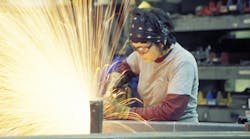Wanted: A Few Good (Female) Machinists, Welders to Fill the Skills Gap
Ask a plant manager or manufacturing CEO where the job openings are, and there’s a good chance the titles “machinist” and “welder” will crop up. Those occupations ranked near the top of hardest-to-fill jobs in IndustryWeek’s Salary Survey this year, along with other “middle-skill” occupations—those requiring more education than a high school diploma but less than a college degree—like industrial maintenance and quality specialists.
And there’s an overall sense the job shortages aren’t going away: 67% of the survey respondents said they’ve struggled to fill a position in the past year due to a lack of skilled candidates, and 78% said their aging workforce is a concern.
But according to a new report sponsored by JP Morgan Chase and conducted by the Institute for Women’s Policy Research, manufacturers may be overlooking a group in plain sight for those unfilled jobs: Women who’ve already mastered lower-paying occupations that require similar skills and abilities as higher-paying jobs.
With minimal training, these women who’ve been working in middle-skill jobs like packaging and filling machine operators and cooks and food batchmakers could move up to higher-paying jobs like welders and machinists.
“Because of gendered assumptions of which jobs may be appropriate for women (assumptions held by women themselves, and by employers, trainers, educators and workforce developers)—women in these jobs may not be seen as a logical pool of talent for these growing middle-skill occupations,” wrote the study authors, led by Ariane Hegewisch, an IWPR researcher who focuses on workplace discrimination and work-life balance.
The report takes a unique approach to finding viable career pathways for women. It uses a database from the U.S. Department of Labor called O*Net that, rather than honing in on very job-specific tasks, describes occupations more broadly through 225 defined job characteristics around work organization, work environment, typical tasks and worker attributes, and knowledge and skills required. It compares O*Net job characteristics with data from the American Community Survey on the percentages of male and female workers in each occupation, identifying occupations that are female dominated yet lower paid that share many characteristics of higher-paid positions. It then hones in on higher-paying jobs that are projected to be in high demand, using U.S. Bureau of Labor Statistics data.
Comparing job characteristics this way brings up careers pathways that might not be obvious, like cooks as an “on-ramp” occupation for truck drivers (the study looks at IT and transportation logistics as well as manufacturing). The two jobs are similar in the amount and type of instruction required to learn the job, in deductive and inductive reasoning tasks, in their need for an ability to visualize physical arrangements and in the extent to which equipment speed determines the pace of work.
Using this method, the researchers found that female packaging and filling machine operators could boost their earnings by 50% by receiving the training needed to become welders, a job that requires similar arm-hand steadiness, manual dexterity and control precision. The median annual earning for welders is $38,762, compared to $25,851 for packaging and filling machine operators.
They also found that with the right additional training, women employed as electrical, electronics and electromechanical assemblers—jobs that are on the decline—could move into machinist jobs that pay almost 50% more.
And cooks, shipping and receiving clerks and food batchmakers could move into higher-paying jobs as manufacturing inspectors, testers, sorters, samplers and weighers.
Employers who see their workers as a long-term investment, says Hegewisch, don’t care so much that new hires know how to perform a specific task, like setting the temperature on the welding machine, which a worker can easily be trained to do. “They want to know, are they going to stick in the job, are they going to like it in the job, are they already working in similar environments?”
Hegewisch hopes the report will help employers see beyond the talent pool they’ve always dipped into because, well, they always have.
Women thus far haven’t benefited from growth in manufacturing jobs: men’s manufacturing employment grew by 614,000 from 2010 to 2014, while women only saw 44,000 new manufacturing jobs.
Women account for 83% of workers in middle-skill occupations that pay less than $30,000 per year, but only 36% of workers in such jobs that pay more than $35,000 per year. And they hold fewer than 10% percent of jobs in the growing areas of advanced manufacturing and transportation/distribution/logistics.
In addition, women’s income is critical to lifting households out of poverty: women are the sole or primary earner in 40% of U.S. families.
Hegewisch said the construction industry is ahead of manufacturing in training programs that attract and retain women. Some are women-only programs, which are rare in manufacturing, says Hegewisch.
“I talked to a couple of colleges who said, ‘Yes, we used to have a woman-only class, but now we don’t, and we have only one or two women [in our programs].’ If it’s women-only the programs are full, and then also the women can kind of help each other afterwards. You have a support group.”
Vermont Works for Women targets women in its manufacturing training, and Chicago Women in the Trades has some manufacturing-focused programs.
The trade programs have strength in numbers and use that leverage to encourage employers to be more accommodating. “What these programs know from placing women, is you go to small manufacturing firms, and they say to work on the machines you have to lift 100 pounds,” says Hegewisch. “And then you find out nobody ever has to lift 100 pounds, and they shouldn’t do it any way because it’s not good for your back.
Programs that advocate for women will say, “‘If you want us to give you skilled workers or candidates, you need to do a written job description and actually say what the job involves and be explicit about it and don’t say ‘You need to lift 100 pounds as part of the job.’
“Which is a big part of getting more women into those nontraditional jobs, is to make explicit what really is required. So that there isn’t such a myth.”





